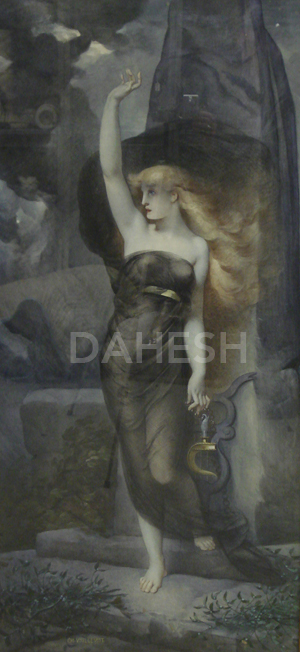André-Charles Voillemot (French, 1823–1893)
The Cumaean Sibyl
Pencil, watercolor and gouache on paper, 51 x 24 in.
Signed lower left: CH. VOILLEMOT
1997.18

André-Charles Voillemot’s watercolor depicts one of the most famous sibyls or prophetesses in mythology. The Cumaean Sibyl served the Temple of Apollo at Cumaea in Italy, and, according to Ovid’s Metamorphoses, was granted eternal life by the god Apollo, who was enamored with her (although the prophetess forgot to ask the sun god for eternal youth as well, and so she became decrepit with age). The Cumaean Sibyl also purportedly sold three of the nine Sibylline Books of prophecies to the Roman King Tarquinis Superbus, which were consulted by the Ancient Romans in times of distress for over 400 years (until 83 BCE, when the temple they were kept in burned down).
Voillemot departs from more typical representations of the Cumaean Sibyl in his watercolor of the prophetess. Typically, she is shown with her famous text, but Voillemot chooses instead to allude to the sibyl’s most famous literary appearance: when she serves as Aeneas’ guide to the underworld in the Golden Bough episode of Virgil’s Aeneid. In book six of the Roman epic, Aeneas seeks out the Cumaean Sibyl’s advice for safe passage into the land of the dead so that he may consult the spirit of his father. She instructs him to gather a branch of mistletoe (called “the golden bough” by Virgil), which Voillemot references through the branches scattered at her feet and the sickle in her left hand (according to Pliny, the Celtic Druid priests held the mistletoe as sacred, so that it could only be cut using a golden sickle, as iron was considered a taboo material).


